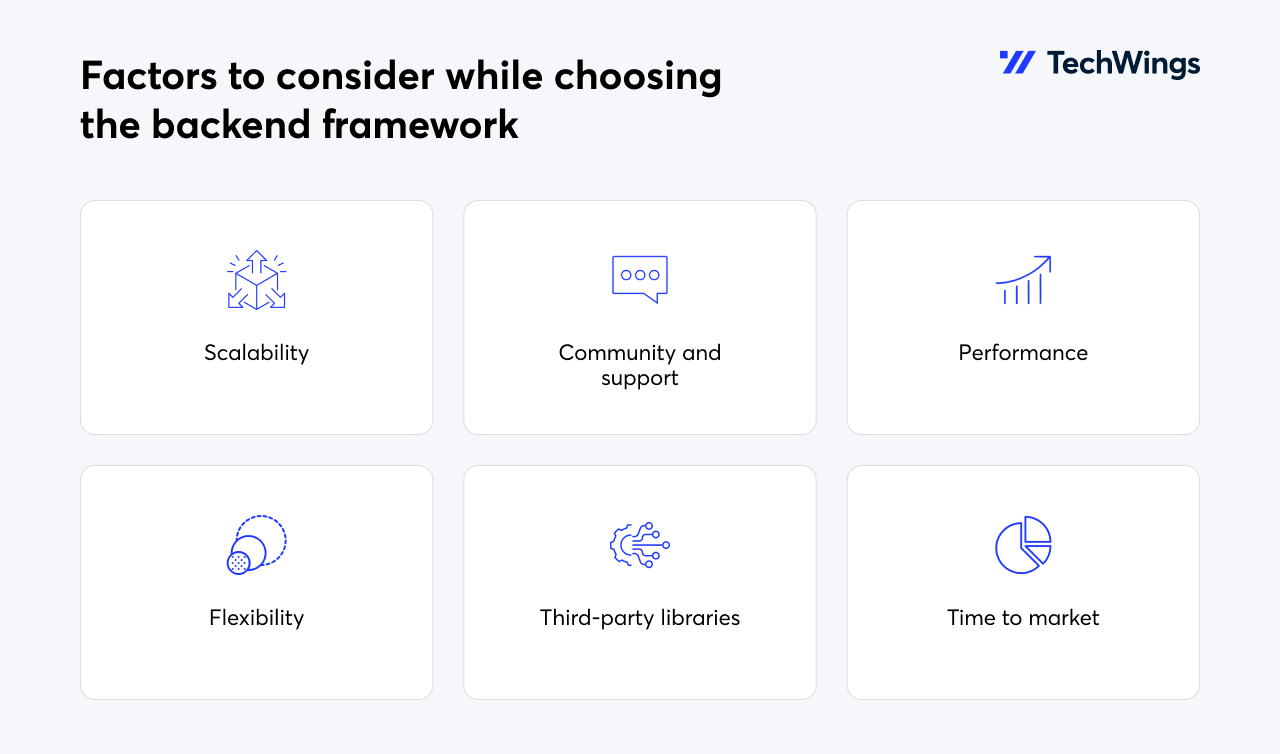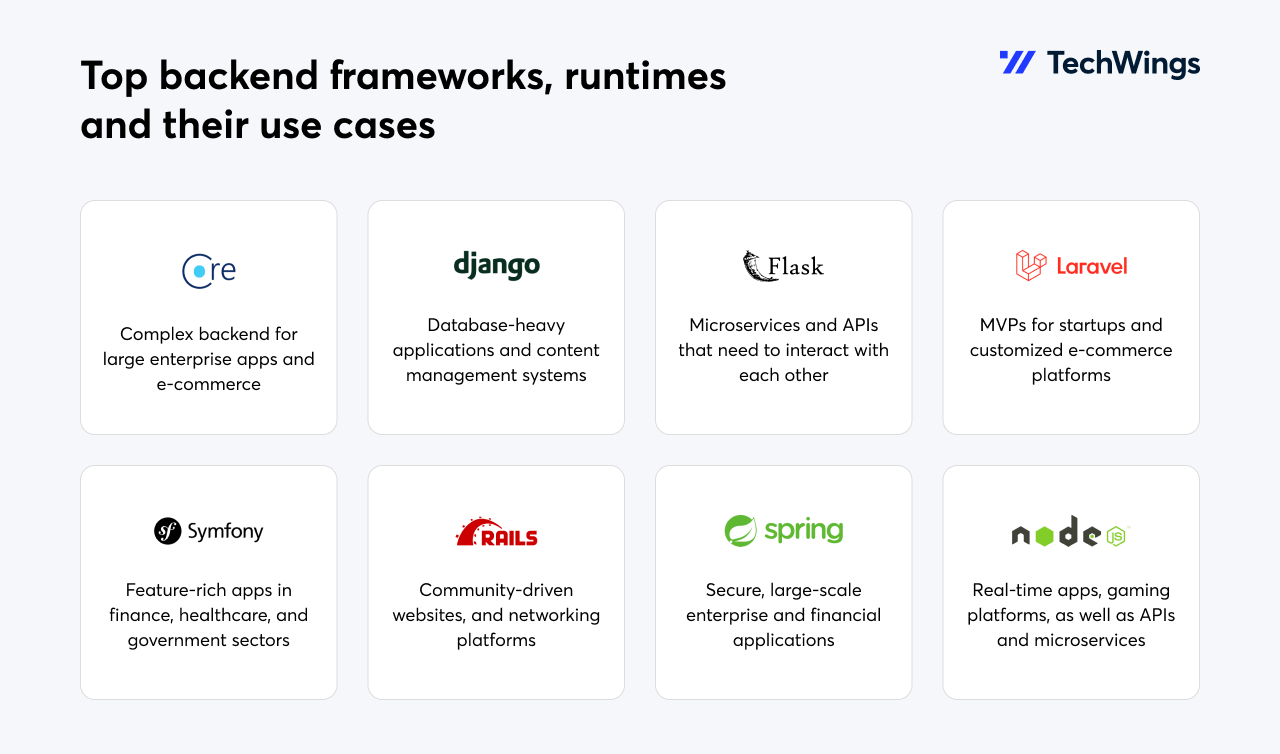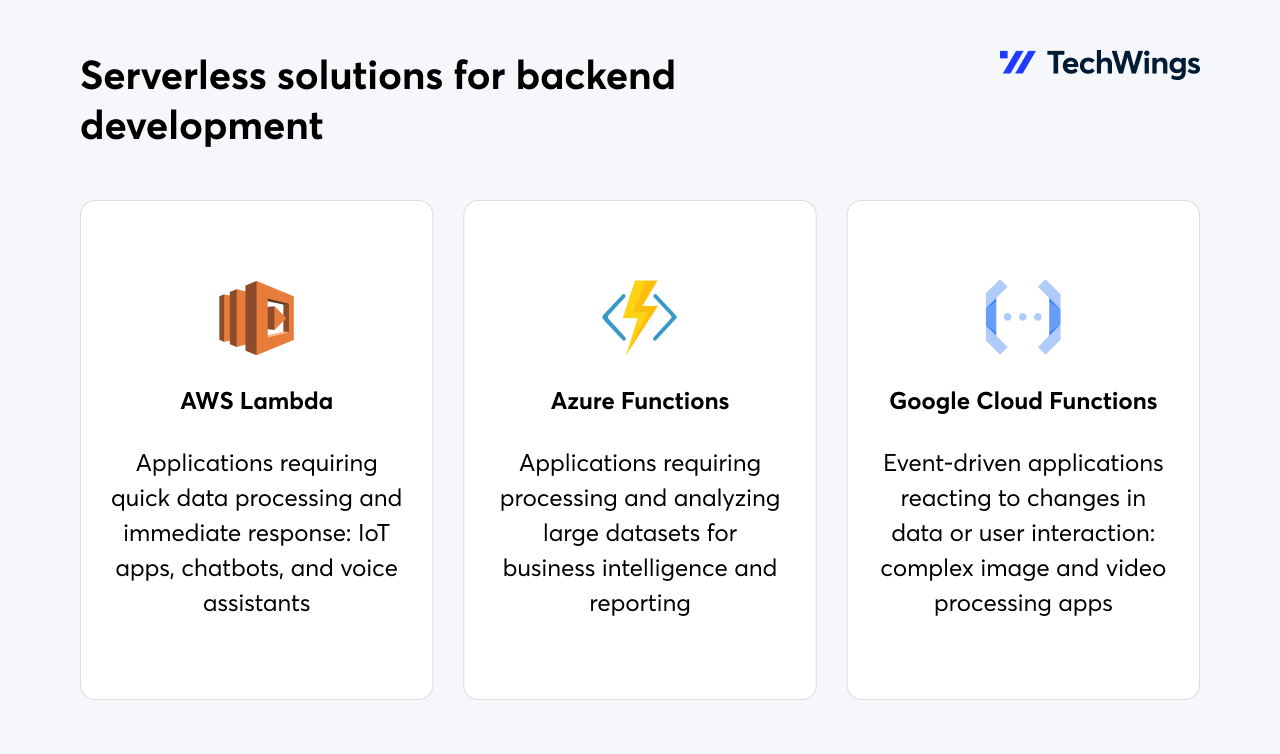While any application feels like a single unit, it actually comprises two major components: the frontend and the backend. What end users interact with and see is the frontend, while the frame of the app is its backend.
Of course, a sleek UI/UX design and rich visuals are crucial, but they would be useless without a robust backend running behind the scenes. Here’s a quick list of what the backend systems are responsible for, just to name a few:
data encryption, authentication, and authorization
managing the storage, retrieval, and manipulation of data used in the application
implementing the core functionality and business rules of the application
ensuring that the app remains responsive and reliable, even under heavy loads
third-party integrations
Given that, it’s safe to say that backend development should be approached with responsibility. Selecting the best backend framework for your app should be your top priority task.
That’s why we’ve created this fundamental comparison guide. Read on to explore the best backend web development frameworks, along with their pros and cons and major use cases.
What is a backend framework?
A backend framework is a pre-built collection of tools, libraries, code structures, and other components that facilitate the development of the server-side systems of an application.
It provides a structured environment for backend developers to build the infrastructure and functionality of the software, saving them time and effort by handling common tasks and challenges.
By removing low-level routines, backend frameworks allow developers to focus on building specific features and functionality.
Factors to consider when choosing the best backend framework for your project
Each project is unique, meaning the question “Which backend framework should I choose?” doesn’t have a one-size-fits-all answer — there’s a lot to consider before making the final decision.
However, we can define some major aspects you should take into account when choosing backend frameworks for web development.
Scalability
Consider the potential growth of your application. Ensure that the chosen framework can handle increased traffic and user demands as your business expands.
Business requirements
Evaluate your application’s specific needs and functionalities. Different backend frameworks for web development excel in different areas, so choose one that aligns with your project’s requirements.
Community and support
Check the size and activity of the framework’s community. A strong community indicates ongoing development, updates, and available resources for troubleshooting.
Documentation
Good documentation is crucial for development efficiency. Make sure the framework of your choice offers comprehensive and up-to-date documentation for easy reference.
Performance
Look into the framework’s performance benchmarks and capabilities. Determine whether it can handle your application’s load and provide fast response times.
Flexibility
Assess whether the framework supports customization to accommodate unique business requirements without requiring major modifications.
Third-party integrations
If your application requires integration with external services or APIs, choose a framework that makes this process seamless.
Time to market
Consider the framework’s ability to accelerate development. A well-established framework with robust features can speed up the development process.
Best backend frameworks to use in 2023
Now that you know how important it is to choose the right backend framework and which factors to consider, let’s explore the top backend frameworks in 2023 (and in the years to come, we’re sure).
ASP.NET Core
ASP.NET Core is an open-source, high-performance framework by Microsoft for building modern applications. ASP.NET Core was developed on top of the .NET Core runtime, optimized for cloud computing.
The framework boasts cloud readiness, a robust modular architecture with built-in security features, and cross-platform capabilities.
ASP.NET Core is often used for building large-scale enterprise applications due to its integration with the Microsoft ecosystem and support for Windows environments. In addition, it’s one of the top backend frameworks for building e-commerce platforms with complex backend requirements and integrations.
Pros
Microsoft ecosystem: ASP.NET Core offers seamless integration with other Microsoft tools and services, which can be advantageous for businesses that have already invested in Microsoft technologies.
Scalability: ASP.NET Core is designed for scalability and can effectively handle high traffic loads.
Security: The framework provides strong security features and supports authentication mechanisms out of the box.
Cons
Vendor lock-in: Extensive use of Microsoft technologies might lead to some vendor lock-in concerns.
Django
The most popular backend framework for Python, the open-source Django, promotes rapid development and clean, pragmatic design. The framework sticks to a Model-View-Controller (MVC) architectural pattern, separating the app’s logic, presentation, and data into individual components.
Django’s built-in admin interface makes it ideal for developing content management systems. Also, its robust ORM (Object-Relational Mapping) is well-suited for applications that heavily rely on database interactions.
Pros
Rapid development: Django’s “batteries-included” philosophy speeds up development by providing built-in components and features.
Admin interface: The framework offers an admin panel out of the box, simplifying content management and administrative tasks.
Cons
Monolithic approach: Django’s opinionated structure might not be as flexible for projects with highly customized requirements.
Flask
Flask is a lightweight Python framework that emphasizes simplicity and flexibility. The framework is also renowned for its detailed documentation.
Flask’s minimalistic nature and flexibility make it suitable for building microservices and APIs that need to interact with each other. Moreover, it’s great for rapidly prototyping web applications and testing new ideas due to its simplicity.
Pros
Modularity: Flask’s minimalist approach allows developers to choose and integrate only the components they need, resulting in a lean application.
Flexible architecture: The framework is well-suited for projects that require a high degree of customization and unique business logic.
Cons
Limited built-in features: Compared to other frameworks, Flask provides fewer built-in tools, which might require more third-party integrations or custom development.
More manual configuration: While flexibility is a strength, it can also lead to more manual configuration compared to more opinionated frameworks.
Laravel
Laravel is one of the most popular backend frameworks for PHP based on MVC architecture. It is known for its elegant syntax and developer-friendly features. The framework also boasts an extensive library and powerful API support.
Laravel’s rapid development capabilities make it an excellent choice when it comes to building MVPs for startups. However, it’s also suitable for building e-commerce platforms and applications requiring quick development and customization.
Pros
Developer productivity: This framework’s expressive syntax and built-in tools boost developer productivity and reduce the time required for common tasks.
Community and ecosystem: Laravel has a strong community and a rich ecosystem of packages that can speed up development.
Cons
PHP-specific: If the team isn’t already familiar with PHP, there might be a learning curve compared to languages like Python or JavaScript.
Performance: While Laravel is suitable for many applications, extremely high-performance scenarios might require additional optimization.
Symfony
Symfony is a PHP framework with a wide array of tools and features designed for developing scalable PHP web applications.
Symfony’s modular architecture and extensive libraries make it ideal for developing complex and feature-rich web applications. It’s often used in finance, healthcare, and government due to its stability and scalability.
Pros
Component reusability: Symfony’s focus on components allows for fine-grained integration of only the necessary functionality, leading to efficient code reuse.
Stability: Its long history and emphasis on stability make it an excellent option for complex projects.
Cons
Complexity: While Symfony provides a lot of power, its learning curve and complexity might be higher compared to more straightforward frameworks.
Configuration overhead: Setting up a Symfony application might involve more configuration due to its flexibility and modularity.
Ruby on Rails
Ruby on Rails (aka Rails) is a web application framework written in Ruby, known for its convention over configuration and rapid development. This makes it a popular choice with startups for building MVPs. Rails has been widely used to build networking platforms and community-driven websites.
Pros
Rapid prototyping: Rails’ conventions enable quick prototyping and development of MVPs.
Developer productivity: The framework’s elegant syntax and emphasis on developer happiness translate into increased job satisfaction and productivity.
Cons
Performance: While Rails is excellent for getting a project off the ground, high-performance applications might require additional optimization.
Spring
The Java-based backend framework, Spring, is renowned for simplifying the complex development process. Spring’s extensive ecosystem and integration capabilities make it a solid choice for building large-scale enterprise applications.
It is also one of the most reliable backend frameworks, so it’s often used in the financial industry for building secure applications.
Pros
Scalability: Suitable for large-scale projects, Spring has a massive user base and is widely adopted in enterprise environments.
Integration capabilities: The framework’s ecosystem provides extensive support for integrating with various technologies and services.
Cons
Java complexity: Java’s verbosity and complexity might require more code than some other languages, potentially impacting development speed.
Configuration overhead: Spring’s flexibility and modularity can result in more configuration work compared to more opinionated frameworks.
Node.js as a foundation of numerous backend frameworks
Node.js is an open-source, server-side JavaScript runtime environment that allows developers to execute JavaScript code on the server. Such prominent backend frameworks as Express, Meteor, Koa, Sails, Nest, and Hapi are built on top of it.
As a leading backend technology, Node.js has gained immense popularity for its speed, scalability, and non-blocking I/O architecture.
Node.js and its frameworks are well-suited for real-time applications that require instant data updates, such as chat apps, online gaming platforms, e-commerce platforms, media streaming services, and collaborative tools. In addition, these technologies are often used to build APIs and microservices due to their lightweight nature and fast execution.
Pros
High performance: Node.js is known for its speed and efficiency. Its non-blocking I/O model allows for handling a large number of concurrent connections with low latency.
Large ecosystem: Node.js has a rich ecosystem of libraries and packages available through npm (Node Package Manager), which significantly accelerates development.
Active community: The runtime boasts a thriving community of developers, which translates into continuous improvement, support, and a wealth of resources.
Scalability: Node.js is designed for scalable projects and can handle high-traffic loads effectively, making it suitable for applications with varying levels of usage.
Cons
Single-threaded nature: Node.js's event-driven architecture might not be the best fit for CPU-intensive tasks that can't be easily parallelized.
Callback hell: In complex applications, the callback-based asynchronous code can become hard to manage, leading to callback hell.
Serverless solutions for backend development
Our backend-focused article wouldn’t be complete without mentioning serverless computing, which is a genuine game changer for building backend systems. Traditional backend development often involves the intricate management of servers, infrastructure scaling, and operational complexities.
However, with the advent of serverless solutions, developers are empowered to focus solely on writing code that powers applications, while cloud providers handle the heavy lifting of infrastructure management.
Here are some of the top serverless computing services we recommend.
AWS Lambda
AWS Lambda is a serverless computing service provided by Amazon Web Services. It’s ideal for building applications requiring quick data processing and immediate response, such as IoT applications, chatbots, and voice assistants.
Google Cloud Functions
Google Cloud Functions is a serverless computing service by Google Cloud. The service is often used for building event-driven apps, i.e., those reacting to events such as changes in data or user interactions. It’s perfect for image and video processing applications and is widely used in the media and entertainment, marketing, e-commerce, and digital publishing sectors.
Azure Functions
Azure Functions is Microsoft’s serverless computing platform. One of the major advantages of this platform is that you can seamlessly integrate your Azure-based application with other Microsoft services for building unified enterprise solutions. Azure Functions is a great choice when it comes to processing and analyzing large datasets for business intelligence and reporting.
Let’s select the best backend web framework for your project together
Let’s face it: The framework you choose for backend development determines how well your future app will align with your unique needs, so it’s crucial to pick the one that best meets your goals.
While selecting a framework can be a daunting endeavor for non-tech decision-makers, we’re here to help. At TechWings, we’ve delivered numerous successful web development projects using various backend frameworks and serverless solutions, and we can offer our deep expertise to help you choose the best backend web framework for your project.



